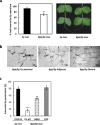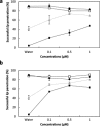Cytoskeleton reorganization/disorganization is a key feature of induced inaccessibility for defence to successive pathogen attacks
- PMID: 27147535
- PMCID: PMC6638220
- DOI: 10.1111/mpp.12424
Cytoskeleton reorganization/disorganization is a key feature of induced inaccessibility for defence to successive pathogen attacks
Abstract
In this work, we investigated the involvement of the long-term dynamics of cytoskeletal reorganization on the induced inaccessibility phenomenon by which cells that successfully defend against a previous fungal attack become highly resistant to subsequent attacks. This was performed on pea through double inoculation experiments using inappropriate (Blumeria graminis f. sp. avenae, Bga) and appropriate (Erysiphe pisi, Ep) powdery mildew fungi. Pea leaves previously inoculated with Bga showed a significant reduction of later Ep infection relative to leaves inoculated only with Ep, indicating that cells had developed induced inaccessibility. This reduction in Ep infection was higher when the time interval between Bga and Ep inoculation ranged between 18 and 24 h, although increased penetration resistance in co-infected cells was observed even with time intervals of 24 days between inoculations. Interestingly, this increase in resistance to Ep following successful defence to the inappropriate Bga was associated with an increase in actin microfilament density that reached a maximum at 18-24 h after Bga inoculation and very slowly decreased afterwards. The putative role of cytoskeleton reorganization/disorganization leading to inaccessibility is supported by the suppression of the induced resistance mediated by specific actin (cytochalasin D, latrunculin B) or general protein (cycloheximide) inhibitors.
Keywords: cell memory; cytoskeleton; disease resistance; inaccessibility; papilla; pea; powdery mildew.
© 2016 BSPP AND JOHN WILEY & SONS LTD.
Figures






Similar articles
-
Host nuclear repositioning and actin polarization towards the site of penetration precedes fungal ingress during compatible pea-powdery mildew interactions.Planta. 2022 Jul 21;256(2):45. doi: 10.1007/s00425-022-03959-3. Planta. 2022. PMID: 35864318
-
Arabidopsis phospholipase dδ is involved in basal defense and nonhost resistance to powdery mildew fungi.Plant Physiol. 2013 Oct;163(2):896-906. doi: 10.1104/pp.113.223503. Epub 2013 Aug 26. Plant Physiol. 2013. PMID: 23979971 Free PMC article.
-
Detection of putative pathogenicity and virulence genes of Erysiphe pisi using genome-wide in-silico search and their suppression by er2 mediated resistance in garden pea.Microb Pathog. 2019 Nov;136:103680. doi: 10.1016/j.micpath.2019.103680. Epub 2019 Aug 20. Microb Pathog. 2019. PMID: 31442573
-
Histo-chemical and biochemical analysis reveals association of er1 mediated powdery mildew resistance and redox balance in pea.Plant Physiol Biochem. 2016 Sep;106:54-63. doi: 10.1016/j.plaphy.2016.04.035. Epub 2016 Apr 23. Plant Physiol Biochem. 2016. PMID: 27135819
-
Gene-Based Resistance to Erysiphe Species Causing Powdery Mildew Disease in Peas (Pisum sativum L.).Genes (Basel). 2022 Feb 8;13(2):316. doi: 10.3390/genes13020316. Genes (Basel). 2022. PMID: 35205360 Free PMC article. Review.
Cited by
-
RUST: A Robust, User-Friendly Script Tool for Rapid Measurement of Rust Disease on Cereal Leaves.Plants (Basel). 2020 Sep 11;9(9):1182. doi: 10.3390/plants9091182. Plants (Basel). 2020. PMID: 32932900 Free PMC article.
-
Tomato Prosystemin Is Much More than a Simple Systemin Precursor.Biology (Basel). 2022 Jan 13;11(1):124. doi: 10.3390/biology11010124. Biology (Basel). 2022. PMID: 35053122 Free PMC article.
-
Legume Crops and Biotrophic Pathogen Interactions: A Continuous Cross-Talk of a Multilayered Array of Defense Mechanisms.Plants (Basel). 2020 Oct 29;9(11):1460. doi: 10.3390/plants9111460. Plants (Basel). 2020. PMID: 33137969 Free PMC article. Review.
-
Host nuclear repositioning and actin polarization towards the site of penetration precedes fungal ingress during compatible pea-powdery mildew interactions.Planta. 2022 Jul 21;256(2):45. doi: 10.1007/s00425-022-03959-3. Planta. 2022. PMID: 35864318
-
Omic characterisation of multi-component defences against the necrotrophic pathogen Pyrenophora tritici-repentis in wheat.Plant Biol (Stuttg). 2025 Apr;27(3):347-361. doi: 10.1111/plb.13746. Epub 2025 Feb 7. Plant Biol (Stuttg). 2025. PMID: 39918991 Free PMC article.
References
-
- Aist, J.R. (1976) Papillae and related wound plugs of plant cells. Annu. Rev. Phytopathol. 14, 145–163.
-
- Alberts, B. , Johnson, A. and Lewis, J. , (2002) Molecular Biology of the Cell, 4th edn. New York: Garland Science.
-
- Carver, T.L.W. , Zeyen, R.J. and Ahlstrand, G.G. (1987) The relationship between insoluble silicon and success or failure of attempted primary penetration by powdery mildew (Erysiphe graminis) germlings on barley. Physiol. Mol. Plant Pathol. 31, 133–148.
-
- Carver, T.L.W. , Zeyen, R.J. , Bushnell, W.R. and Robbins, M.P. (1994a) Inhibition of phenylalanine ammonia‐lyase and cinnamyl alcohol dehydrogenase increases quantitative susceptibility of barley to powdery mildew (Erysiphe graminis DC). Physiol. Mol. Plant Pathol. 44, 261–272.
-
- Carver, T.L.W. , Zeyen, R.J. , Robbins, M.P. , Vance, C.P. and Boyles, D.A. (1994b) Suppression of host cinnamyl alcohol‐dehydrogenase and phenylalanine ammonia‐lyase increases oat epidermal‐cell susceptibility to powdery mildew penetration. Physiol. Mol. Plant Pathol. 44, 243–259.
Publication types
MeSH terms
Substances
LinkOut - more resources
Full Text Sources
Other Literature Sources

